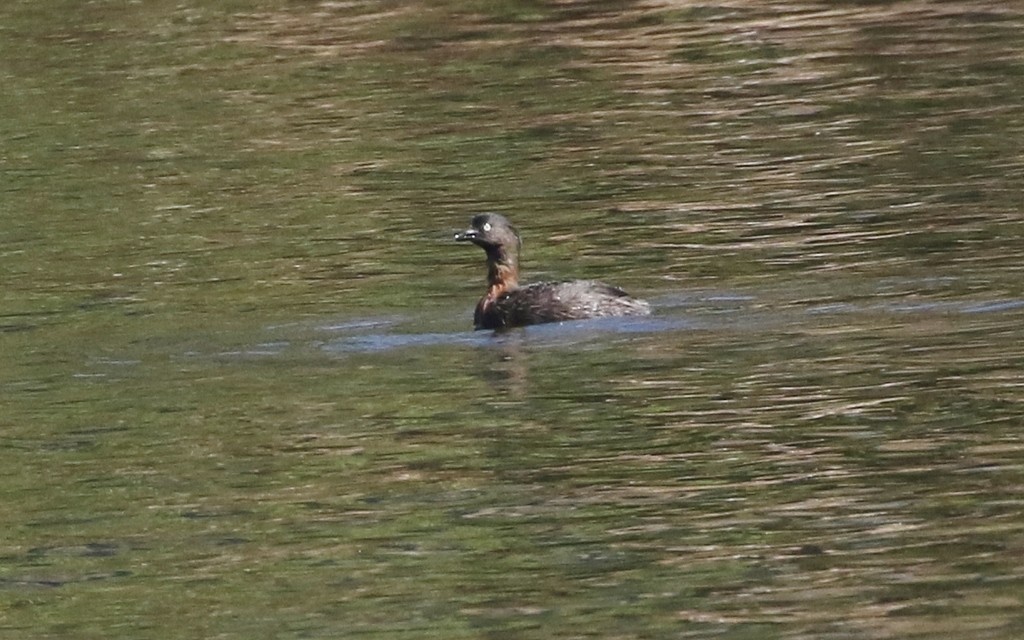New Zealand Grebe
A species of Hoary-headed and New Zealand Grebes Scientific name : Poliocephalus rufopectus Genus : Hoary-headed and New Zealand Grebes
New Zealand Grebe, A species of Hoary-headed and New Zealand Grebes
Botanical name: Poliocephalus rufopectus
Genus: Hoary-headed and New Zealand Grebes
Content
Description General Info
 Photo By silversea_starsong , used under CC-BY-NC-4.0 /Cropped and compressed from original
Photo By silversea_starsong , used under CC-BY-NC-4.0 /Cropped and compressed from original Description
The New Zealand grebe has dark brown plumage, a small black head with fine silver feathers, a black pointed bill and characteristic yellow eyes. It grows to about 29 cm, and weigh about 250 g. Non-breeding individuals have a paler plumage and females tend to be a bit lighter, smaller and have a slightly shorter bill than males. 
Size
30 cm
Nest Placement
Floating
Feeding Habits
New Zealand Grebe primarily consumes aquatic insects, larvae, and small molluscs, occasionally eating fish and crayfish. New Zealand Grebe forage by diving and feeding underwater. Its pointed bill suits its invertebrate-based diet.
Habitat
New Zealand Grebe predominantly resides in freshwater environments such as shallow lakes, ponds, and protected inlets with dense vegetation. These birds favor small, calm aquatic habitats with emergent and shoreline vegetation, but can also be found in larger lakes with tranquil inlets, artificial wetlands, farm ponds, and sewage pond areas. Non-breeding flocks may occupy more open waters. Although grebes generally adapt to various water bodies, new Zealand Grebe typically avoids estuarine and coastal waters.
Dite type
Piscivorous
General Info
Feeding Habits
Bird food type
Behavior
These freshwater diving birds usually fly only at night, whilst during the day, they are always found in the water, swimming on the surface and frequently diving to feed. Thus, if they are in danger or get disturbed at daytime they do not flee by flying, but swimming or diving away. During autumn and winter, they are found forming flocks, while during the breeding season they are mostly seen in monogamous pairs. They show aggressive territorial behaviour towards intruders and the otherwise silent species give short calls throughout the breeding season and when in danger. 
Distribution Area
This grebe species inhabits mainly shallow freshwater lakes, ponds and sheltered inlets. Currently it is found mainly in the North Island, where it is well distributed on the coastal lakes of the West coast from North Cape to Pukekohe and from Southern Taranaki to Paraparaumu, as well as on ponds of the Volcanic Plateau, Gisborne, Hawkes bay and the Wairarapa. Formerly this species was also present in the lowland lakes of the South Island, but underwent a rapid decline, for unknown reasons, in the 19th century - the last regular breeding record in the South Island was in 1941. In 2012 a pair bred near Takaka for the first time in recent history. 
Species Status
This species is endemic to New Zealand and is nowadays only found in the North Island. In 1994, the IUCN classified the New Zealand grebe as Endangered, but due to conservation actions including habitat management, its population has recently increased to around 1,900-2,000 birds and was reclassified as Near Threatened in 2016. Human activity currently has a net benefit as artificial habitat, including farm dams and ponds formed for stock water supplies, increases the area of occupation for the grebes. So, although the population is still quite small it is thought not to be in decline anymore. 